Abstract
1. The benzoylguanidine derivative Hoe 694 ((3-methylsulphonyl-4- piperidino-benzoyl) guanidine methanesulphonate) was characterized as an inhibitor of Na+/H+ exchange in rabbit erythrocytes, rat platelets and bovine endothelial cells. The potency of the compound was slightly lower or comparable to ethylisopropyl amiloride (EIPA). 2. To investigate a possible cardioprotective role of the Na+/H+ exchange inhibitor Hoe 694, rat isolated working hearts were subjected to ischaemia and reperfusion. In these experiments all untreated hearts suffered ventricular fibrillation on reperfusion. Addition of 10(-7) M Hoe 694 to the perfusate almost abolished reperfusion arrhythmias in the rat isolated working hearts. 3. Hoe 694 reduced the release of lactate dehydrogenase (LDH) and creatine kinase (CK), which are indicators of cellular damage during ischaemia, into the venous effluent of the hearts by 60% and 54%, respectively. 4. The tissue content of glycogen at the end of the experiments was increased by 60% and the high energy phosphates ATP and creatine phosphate were increased by 240% and 270% respectively in the treated hearts as compared to control hearts. 5. Antiischaemic effects of the Na+/H+ exchange inhibitor, Hoe 694, were investigated in a second experiment in anaesthetized rats undergoing coronary artery ligation. In these animals, pretreatment with Hoe 694 caused a dose-dependent reduction of ventricular premature beats and ventricular tachycardia as well as a complete suppression of ventricular fibrillation down to doses of 0.1 mg kg-1, i.v. Blood pressure and heart rate remained unchanged. 6. We conclude that the new Na+/H+ exchange inhibitor, Hoe 694, shows cardioprotective and antiarrhythmic effects in ischaemia and reperfusion in rat isolated hearts and in anaesthetized rats.(ABSTRACT TRUNCATED AT 250 WORDS)
Full text
PDF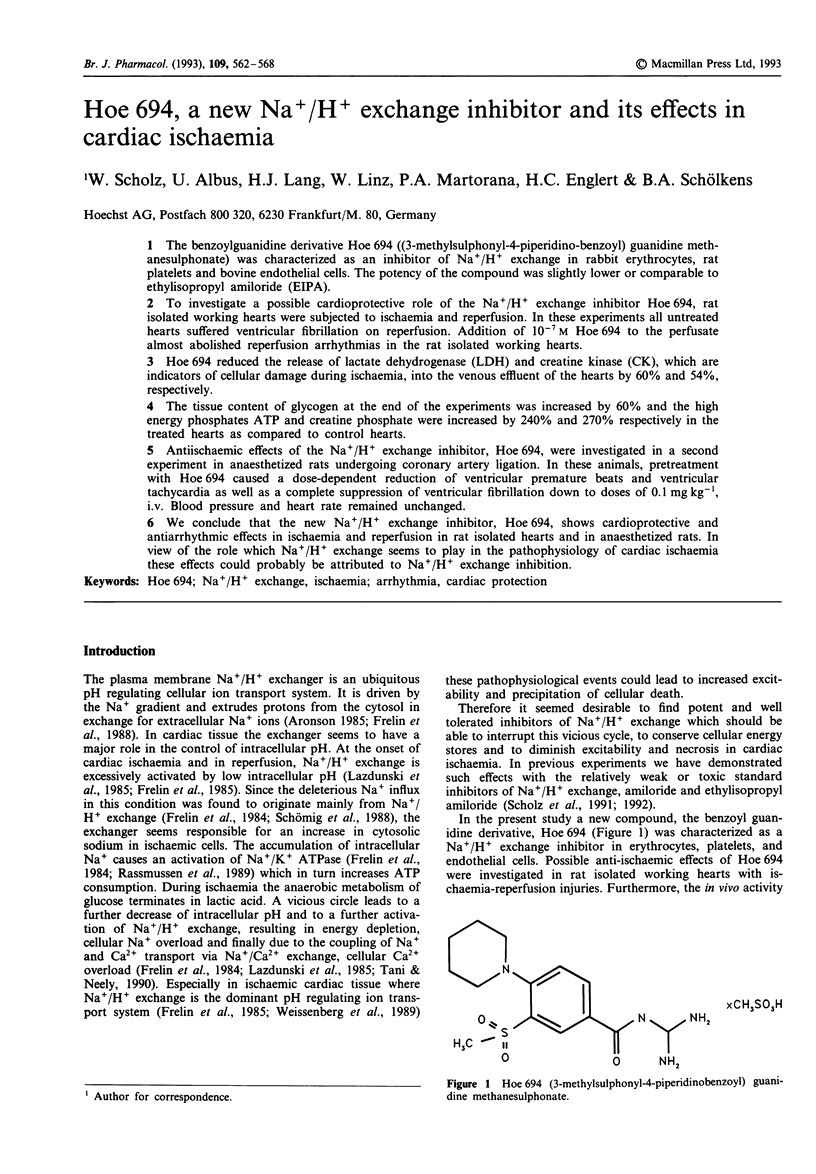
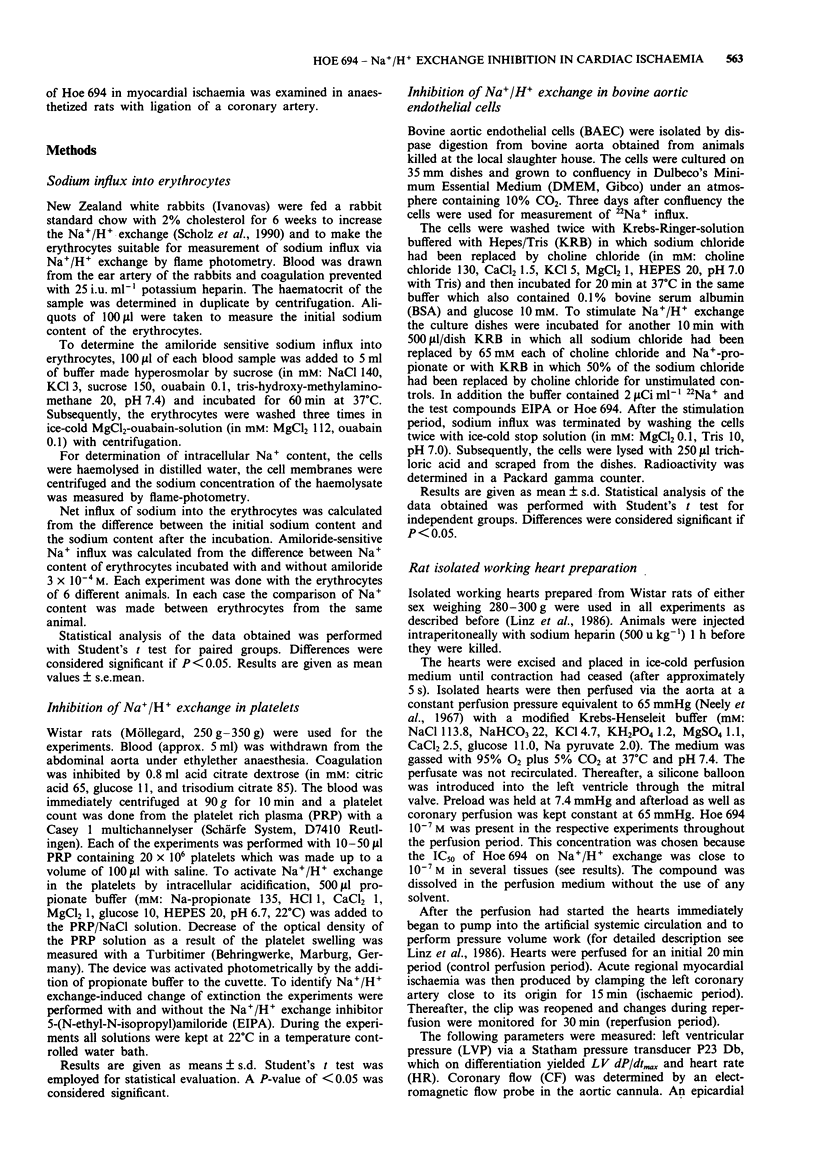
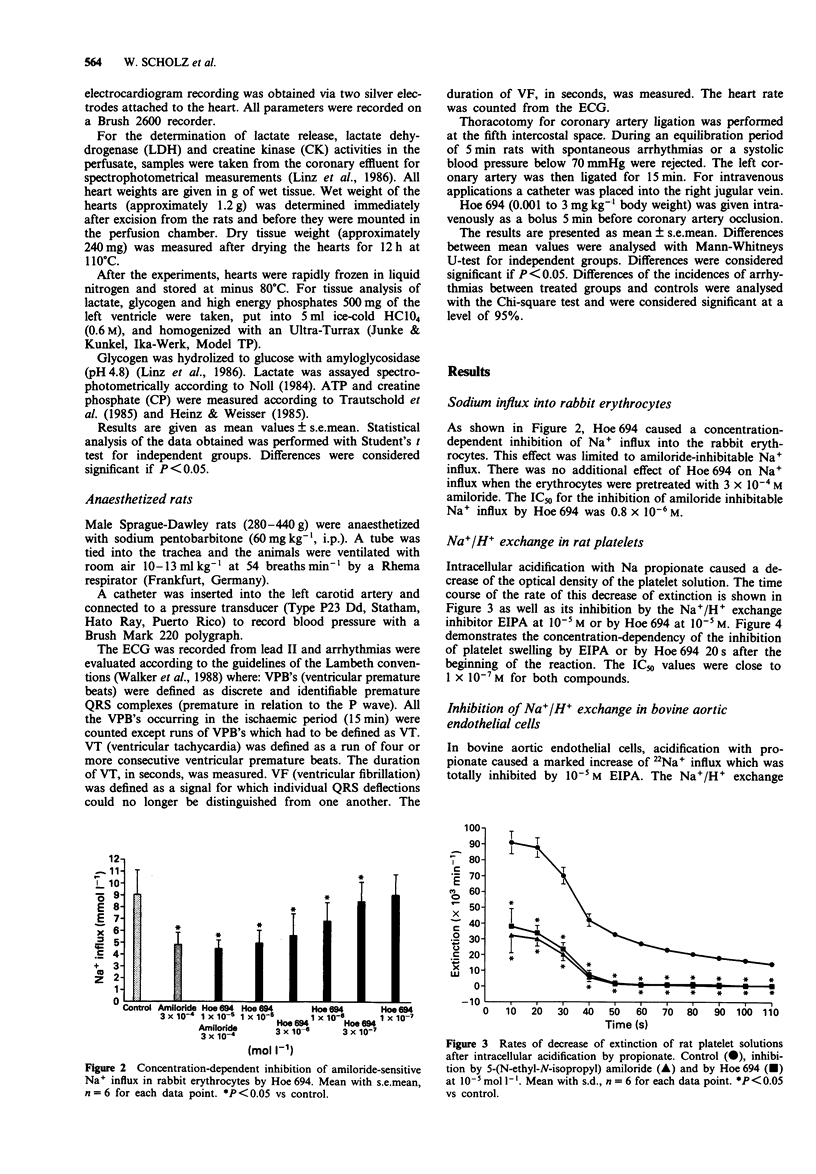
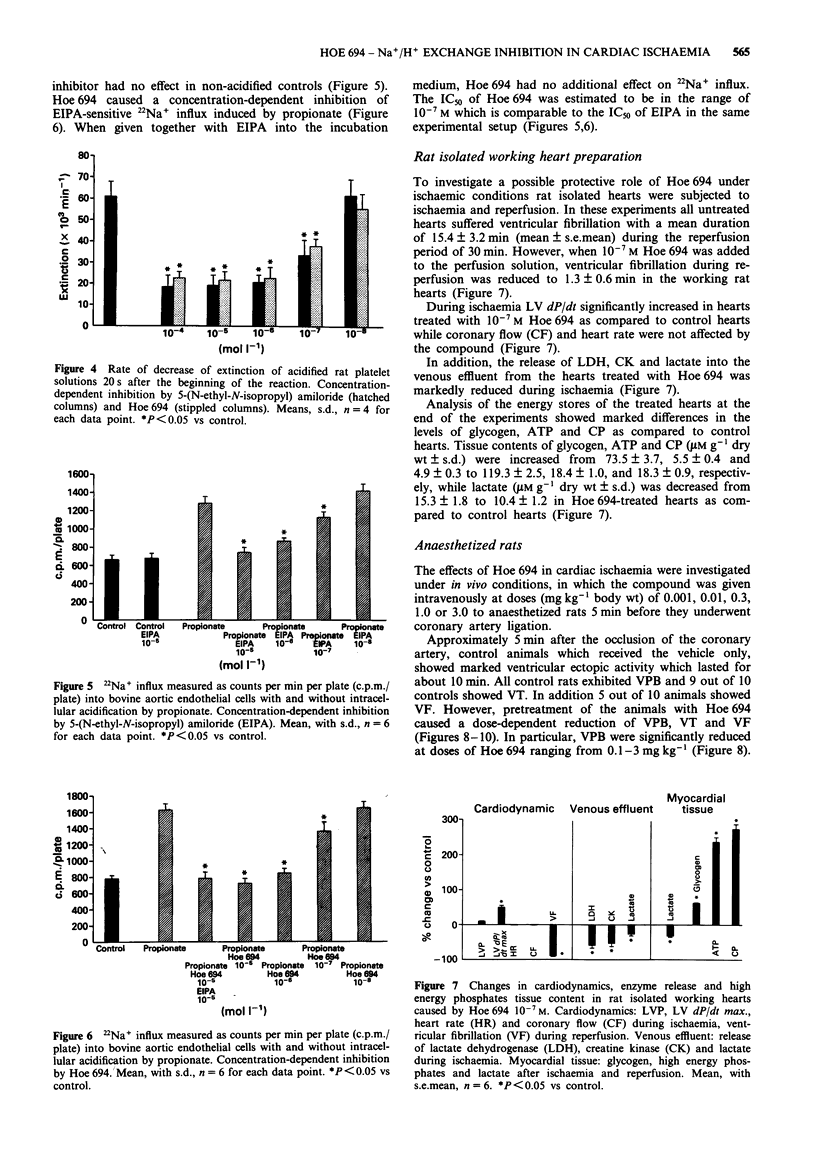
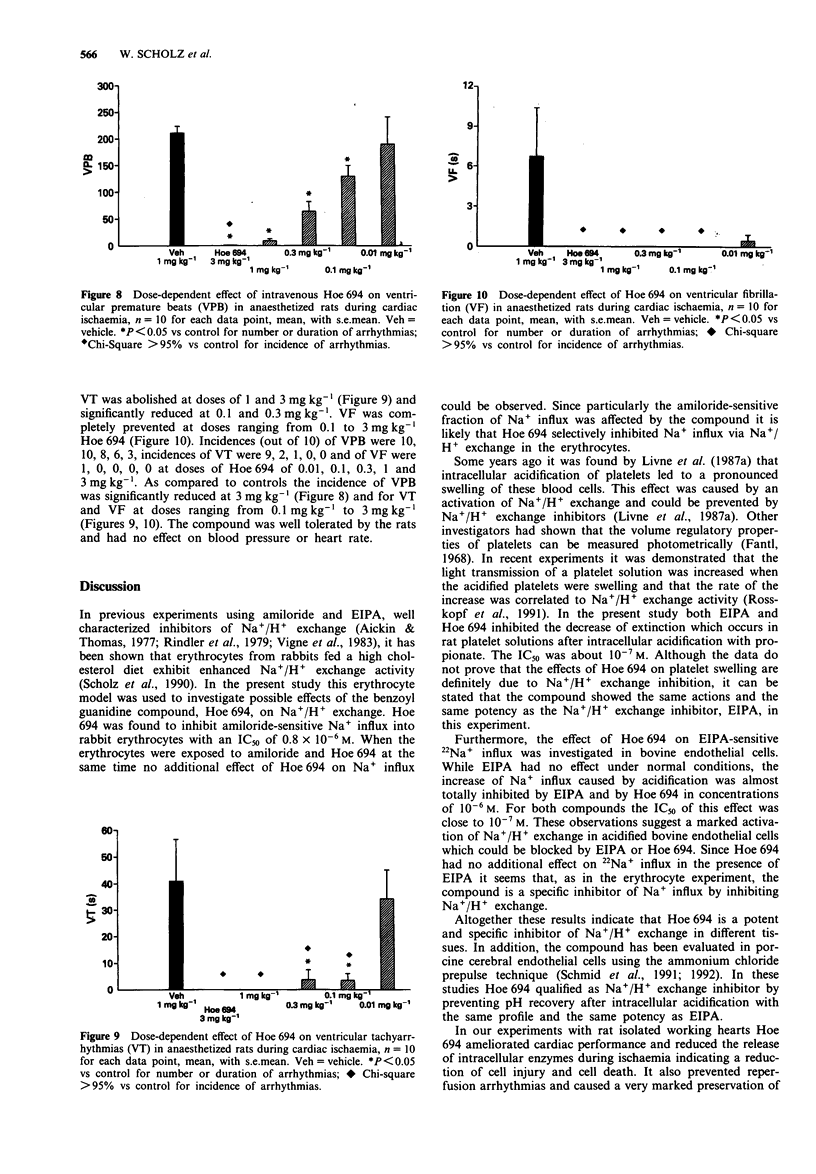
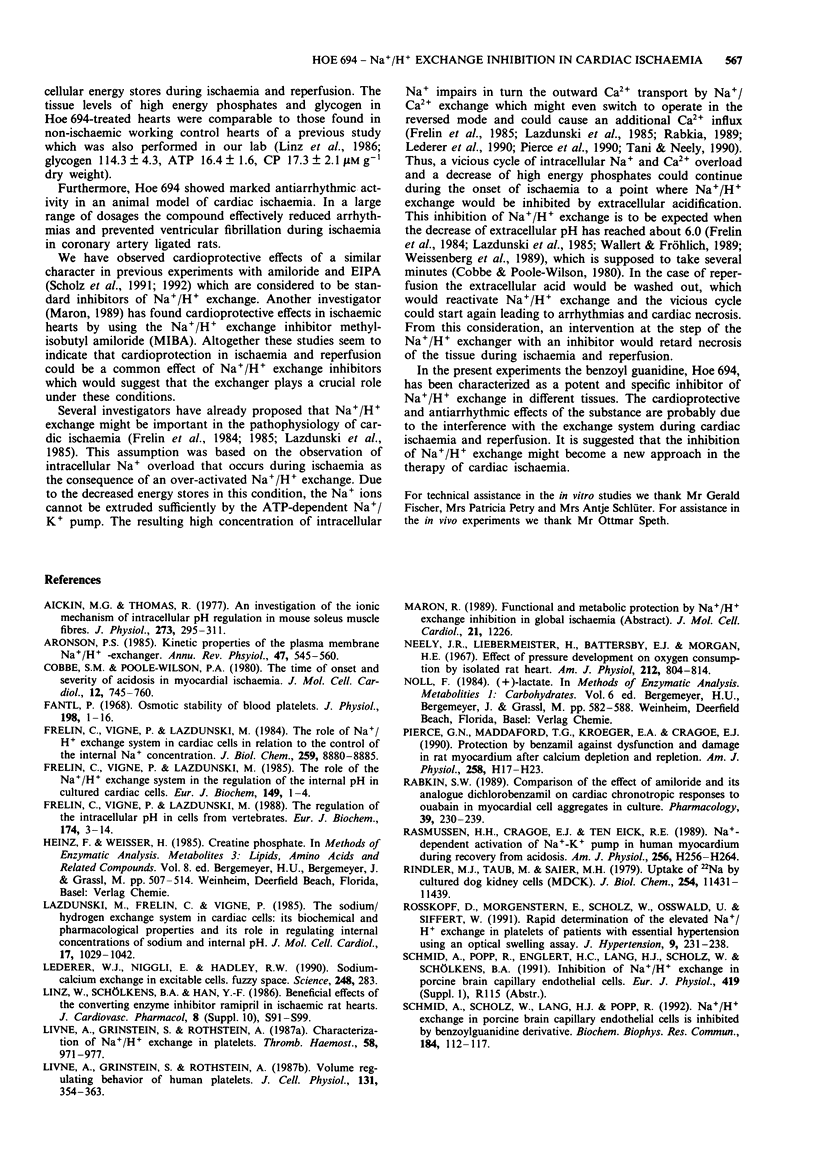
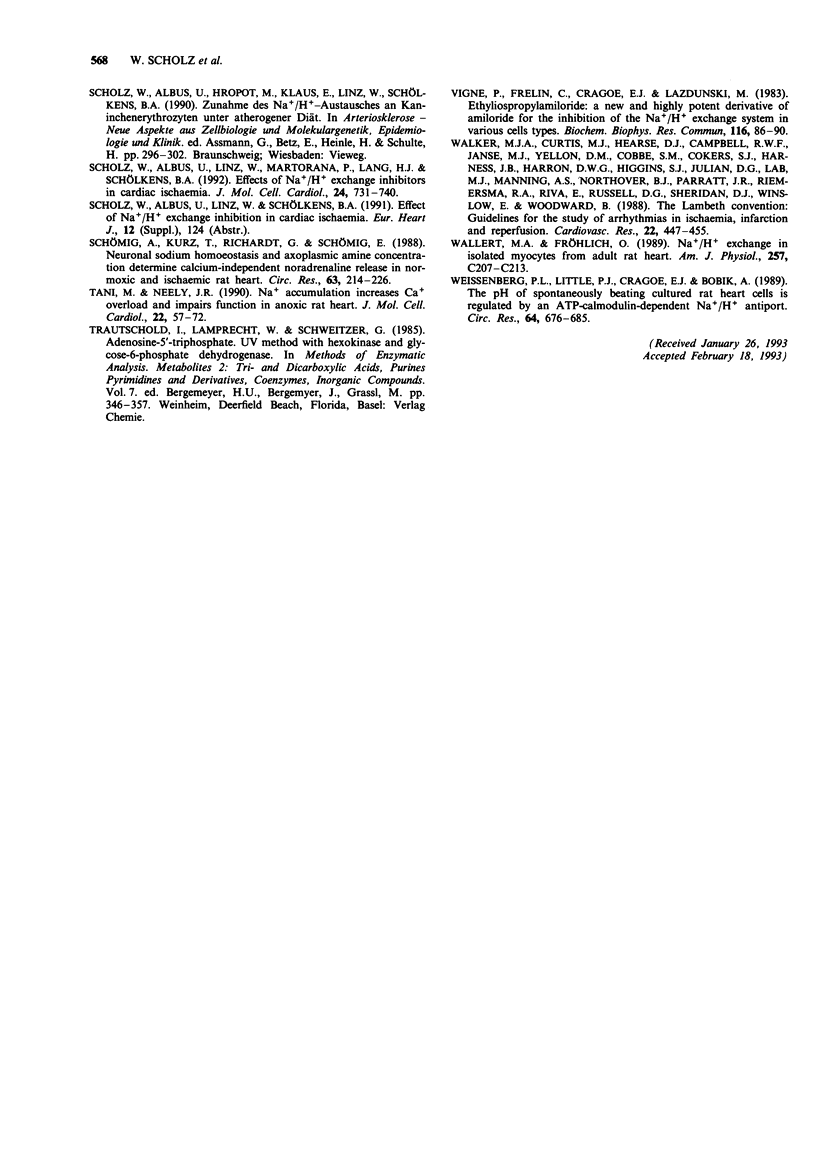
Selected References
These references are in PubMed. This may not be the complete list of references from this article.
- Aickin C. C., Thomas R. C. An investigation of the ionic mechanism of intracellular pH regulation in mouse soleus muscle fibres. J Physiol. 1977 Dec;273(1):295–316. doi: 10.1113/jphysiol.1977.sp012095. [DOI] [PMC free article] [PubMed] [Google Scholar]
- Aronson P. S. Kinetic properties of the plasma membrane Na+-H+ exchanger. Annu Rev Physiol. 1985;47:545–560. doi: 10.1146/annurev.ph.47.030185.002553. [DOI] [PubMed] [Google Scholar]
- Cobbe S. M., Poole-Wilson P. A. The time of onset and severity of acidosis in myocardial ischaemia. J Mol Cell Cardiol. 1980 Aug;12(8):745–760. doi: 10.1016/0022-2828(80)90077-2. [DOI] [PubMed] [Google Scholar]
- Fantl P. Osmotic stability of blood platelets. J Physiol. 1968 Sep;198(1):1–16. doi: 10.1113/jphysiol.1968.sp008590. [DOI] [PMC free article] [PubMed] [Google Scholar]
- Frelin C., Vigne P., Ladoux A., Lazdunski M. The regulation of the intracellular pH in cells from vertebrates. Eur J Biochem. 1988 May 16;174(1):3–14. doi: 10.1111/j.1432-1033.1988.tb14055.x. [DOI] [PubMed] [Google Scholar]
- Frelin C., Vigne P., Lazdunski M. The role of the Na+/H+ exchange system in cardiac cells in relation to the control of the internal Na+ concentration. A molecular basis for the antagonistic effect of ouabain and amiloride on the heart. J Biol Chem. 1984 Jul 25;259(14):8880–8885. [PubMed] [Google Scholar]
- Frelin C., Vigne P., Lazdunski M. The role of the Na+/H+ exchange system in the regulation of the internal pH in cultured cardiac cells. Eur J Biochem. 1985 May 15;149(1):1–4. doi: 10.1111/j.1432-1033.1985.tb08884.x. [DOI] [PubMed] [Google Scholar]
- Lazdunski M., Frelin C., Vigne P. The sodium/hydrogen exchange system in cardiac cells: its biochemical and pharmacological properties and its role in regulating internal concentrations of sodium and internal pH. J Mol Cell Cardiol. 1985 Nov;17(11):1029–1042. doi: 10.1016/s0022-2828(85)80119-x. [DOI] [PubMed] [Google Scholar]
- Lederer W. J., Niggli E., Hadley R. W. Sodium-calcium exchange in excitable cells: fuzzy space. Science. 1990 Apr 20;248(4953):283–283. doi: 10.1126/science.2326638. [DOI] [PubMed] [Google Scholar]
- Linz W., Schölkens B. A., Han Y. F. Beneficial effects of the converting enzyme inhibitor, ramipril, in ischemic rat hearts. J Cardiovasc Pharmacol. 1986;8 (Suppl 10):S91–S99. doi: 10.1097/00005344-198600101-00017. [DOI] [PubMed] [Google Scholar]
- Livne A., Grinstein S., Rothstein A. Characterization of Na+/H+ exchange in platelets. Thromb Haemost. 1987 Dec 18;58(4):971–977. [PubMed] [Google Scholar]
- Livne A., Grinstein S., Rothstein A. Volume-regulating behavior of human platelets. J Cell Physiol. 1987 Jun;131(3):354–363. doi: 10.1002/jcp.1041310307. [DOI] [PubMed] [Google Scholar]
- Neely J. R., Liebermeister H., Battersby E. J., Morgan H. E. Effect of pressure development on oxygen consumption by isolated rat heart. Am J Physiol. 1967 Apr;212(4):804–814. doi: 10.1152/ajplegacy.1967.212.4.804. [DOI] [PubMed] [Google Scholar]
- Pierce G. N., Maddaford T. G., Kroeger E. A., Cragoe E. J. Protection by benzamil against dysfunction and damage in rat myocardium after calcium depletion and repletion. Am J Physiol. 1990 Jan;258(1 Pt 2):H17–H23. doi: 10.1152/ajpheart.1990.258.1.H17. [DOI] [PubMed] [Google Scholar]
- Rabkin S. W. Comparison of the effect of amiloride and its analogue dichlorobenzamil on cardiac chronotropic responses to ouabain in myocardial cell aggregates in culture. Pharmacology. 1989;39(4):230–239. doi: 10.1159/000138602. [DOI] [PubMed] [Google Scholar]
- Rasmussen H. H., Cragoe E. J., Jr, ten Eick R. E. Na+-dependent activation of Na+-K+ pump in human myocardium during recovery from acidosis. Am J Physiol. 1989 Jan;256(1 Pt 2):H256–H264. doi: 10.1152/ajpheart.1989.256.1.H256. [DOI] [PubMed] [Google Scholar]
- Rindler M. J., Taub M., Saier M. H., Jr Uptake of 22Na+ by cultured dog kidney cells (MDCK). J Biol Chem. 1979 Nov 25;254(22):11431–11439. [PubMed] [Google Scholar]
- Rosskopf D., Morgenstern E., Scholz W., Osswald U., Siffert W. Rapid determination of the elevated Na(+)-H+ exchange in platelets of patients with essential hypertension using an optical swelling assay. J Hypertens. 1991 Mar;9(3):231–238. [PubMed] [Google Scholar]
- Schmid A., Scholz W., Lang H. J., Popp R. Na+/H+ exchange in porcine cerebral capillary endothelial cells is inhibited by a benzoylguanidine derivative. Biochem Biophys Res Commun. 1992 Apr 15;184(1):112–117. doi: 10.1016/0006-291x(92)91165-m. [DOI] [PubMed] [Google Scholar]
- Scholz W., Albus U., Linz W., Martorana P., Lang H. J., Schölkens B. A. Effects of Na+/H+ exchange inhibitors in cardiac ischemia. J Mol Cell Cardiol. 1992 Jul;24(7):731–739. doi: 10.1016/0022-2828(92)93387-y. [DOI] [PubMed] [Google Scholar]
- Schömig A., Kurz T., Richardt G., Schömig E. Neuronal sodium homoeostatis and axoplasmic amine concentration determine calcium-independent noradrenaline release in normoxic and ischemic rat heart. Circ Res. 1988 Jul;63(1):214–226. doi: 10.1161/01.res.63.1.214. [DOI] [PubMed] [Google Scholar]
- Tani M., Neely J. R. Na+ accumulation increases Ca2+ overload and impairs function in anoxic rat heart. J Mol Cell Cardiol. 1990 Jan;22(1):57–72. doi: 10.1016/0022-2828(90)90972-5. [DOI] [PubMed] [Google Scholar]
- Vigne P., Frelin C., Cragoe E. J., Jr, Lazdunski M. Ethylisopropyl-amiloride: a new and highly potent derivative of amiloride for the inhibition of the Na+/H+ exchange system in various cell types. Biochem Biophys Res Commun. 1983 Oct 14;116(1):86–90. doi: 10.1016/0006-291x(83)90384-4. [DOI] [PubMed] [Google Scholar]
- Walker M. J., Curtis M. J., Hearse D. J., Campbell R. W., Janse M. J., Yellon D. M., Cobbe S. M., Coker S. J., Harness J. B., Harron D. W. The Lambeth Conventions: guidelines for the study of arrhythmias in ischaemia infarction, and reperfusion. Cardiovasc Res. 1988 Jul;22(7):447–455. doi: 10.1093/cvr/22.7.447. [DOI] [PubMed] [Google Scholar]
- Wallert M. A., Fröhlich O. Na+-H+ exchange in isolated myocytes from adult rat heart. Am J Physiol. 1989 Aug;257(2 Pt 1):C207–C213. doi: 10.1152/ajpcell.1989.257.2.C207. [DOI] [PubMed] [Google Scholar]
- Weissberg P. L., Little P. J., Cragoe E. J., Jr, Bobik A. The pH of spontaneously beating cultured rat heart cells is regulated by an ATP-calmodulin-dependent Na+/H+ antiport. Circ Res. 1989 Apr;64(4):676–685. doi: 10.1161/01.res.64.4.676. [DOI] [PubMed] [Google Scholar]


